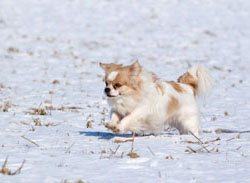Tibetan Spaniels are small dogs with double coats that come in gold, cream, and sable. All colors and mixtures of colors are permissible. There may be white markings on the feet. The coat is silky, flat lying, and of moderate length. These dogs have oval, dark, medium-sized eyes and a slightly domed skull. Their ears are well feathered, pendant, and of medium size. Tibetan Spaniels measure 10 inches tall at the shoulder and weigh 9 to 15 pounds.
This breed is generally happy and enjoys playing games with human family members.
Highly intelligent, friendly, and outgoing, Tibetan Spaniels are ideal pets for families with older children. These dogs tend to be aloof with strangers, but they are loving with family and they crave human attention and affection. Because this breed has minimal exercise needs, they make great apartment dogs.
Tibetan Spaniels are not true spaniels. The breed was called an "epagneul" in French, which is a term from the Middle Ages that refers to small comforter dogs.
Highly intelligent, friendly, and outgoing, the Tibetan Spaniel is a fun companion animal for families with older children. These dogs also tend to be watchful, protective, and reserved around strangers, which makes them a good choice for homes in need of a watchdog. They're also very cuddly and get along with most other cats and dogs.
This breed is generally happy and enjoys playing games with human family members. Outdoor time is also important, but the Tibetan Spaniel's exercise needs are minimal. A short daily walk on a leash and a casual romp in the yard are all these dogs need to remain mentally and physically healthy.
Tibetan Spaniels are independent, stubborn, and fastidious, and the breed is often described as being very similar to a cat. It's normal to find these dogs perched on the back of a couch or chair, grooming like a feline and watching the goings-on in the house. Tibetan Spaniels need to live indoors.
Tibetan Spaniels are generally a healthy and long-lived breed, but they are known to suffer from a few health conditions that can negatively affect length or quality of life. Adoptions and purchases should be done through a reputable source to help ensure a healthy puppy.
Allergies, patellar luxation, epilepsy, deafness, and respiratory problems due to having a short muzzle are all seen in this breed. Tibetan Spaniels are also prone to certain eye conditions, including retinal dysplasia and entropion. One eye condition called progressive retinal atrophy leads to blindness.
Routine veterinary checkups, proper nutrition, daily exercise, and timely canine vaccinations help Tibetan Spaniels live a full and active life of up to 15 years.
Known for being stubborn, smart, and headstrong, Tibetan Spaniels can be a challenge to train. These dogs may insist on having their own way, and they have a tendency to disobey commands. They also may feel the urge to break free from the leash and run off. These behaviors can get them into trouble quickly, so it's a good idea to focus on getting these dogs to listen.
Tibetan Spaniels generally respond best to positive reinforcement techniques, such as play, praise, and food rewards. Rewards and treats should be used sparingly and only to reinforce good behaviors. Gentle correction is beneficial when these dogs do not behave; harsh criticism and punishment can worsen behavior. Patience and consistency are important.
Socializing the Tibetan Spaniel from an early age will help increase tolerance and confidence and ensure these dogs are better able to get along with other pets. Puppy kindergarten is great for young puppies, and older dogs will benefit from walks around town, time at the dog park, and trips to neighbors' homes.
Brushing and combing the Tibetan Spaniel two or three times each week is generally sufficient to keep the coat healthy. A good brushing will distribute skin oils throughout the coat while removing dirt and debris. Brushing every few days will also keep loose hair under control. Combing the feathering between the toes will prevent tangles and mats from developing. These dogs do not need trimming.
These dogs are naturally clean and only need bathing about every eight weeks. A gentle canine shampoo will wash away any stinky or harmful substances without drying out the skin or causing irritation. It's essential to rinse thoroughly after bathing to remove traces of soap residue.
To prevent snagging and breaking, the nails should be clipped every week or two. Additionally, the teeth need daily brushing to protect against periodontal disease, and the ears should be checked weekly for signs of wax accumulation or infection. The outer ears can be cleaned with a veterinarian-approved otic cleanser and cotton balls.
Tibetan Spaniels can be found in early Eastern art that dates all the way back to 1100 BC. Referred to as "little lions" by their owners, the dogs were prized as companion animals in Tibetan monasteries, where they would perch on monastery walls in order to watch over the countryside.
The development of the Tibetan Spaniel was influenced by breeds in China and other Buddhist counties. The dogs were often sent between countries as gifts and were given to Chinese dignitaries over the years. With each move, the dogs were probably crossed with other breeds, such as the Japanese Chin and Pekingese, until the breed developed into what we know today.
The first Tibetan Spaniel made its way to England in the late 1800s, but no real breeding program was started for several decades. In the 1920s, the Griegs (Tibetan Spaniel promoters) obtained several Tibetan Spaniels, but only one survived World War II. This dog would go on to contribute to modern pedigrees. The breed did not come to America until the 1960s, and it has only slowly increased in number.
The American Kennel Club officially recognized the Tibetan Spaniel in 1983.

